Makeup Routines Introduction
In the world of beauty, mastering makeup routines can feel like navigating a labyrinth of products, techniques, and trends. For beginners, this maze can seem daunting, even discouraging.
But fear not, for we’ve compiled a comprehensive guide to makeup routines that are not only simple but also perfect for those taking their first steps into the glamorous world of cosmetics.
The Importance of a Makeup Routine
Before diving into the specifics, let’s discuss why having a makeup routine is crucial. A consistent routine not only saves time but also ensures a polished look every time you step out.
Moreover, it allows beginners to familiarize themselves with different products and techniques gradually, building confidence along the way.
Cleaning and Moisturizing
Every great makeup look starts with a clean canvas. Start by completely purifying your face to eliminate any soil, oil, or pollution.
Follow up with a hydrating moisturizer to prep your skin for Makeup Routines application. This step is essential, as it creates a smooth base for the rest of your routine.
Primer
Primer acts as a base for your makeup routines, helping it last longer and appear more vibrant. Apply a pea-sized amount evenly across your face, focusing on areas prone to oiliness or large pores.
Not only does primer extend the wear of your makeup, but it also smooths out the skin’s texture, creating a flawless finish.
Foundation
Choosing the right foundation is key to achieving a natural-looking complexion. Opt for a formula that matches your skin tone and type. Using a makeup sponge or brush, blend the foundation evenly onto your skin, starting from the center of your face and blending outwards. Build coverage gradually until you achieve your desired look.
Concealer
Concealer is a lifesaver when it comes to covering imperfections such as blemishes, dark circles, and redness.
Apply concealer sparingly to the areas that need extra coverage, then blend seamlessly with a makeup sponge or brush. Remember to choose a shade that matches your skin tone for a seamless finish.
Setting Powder
To prevent your makeup from creasing or melting throughout the day, set it with a translucent setting powder.
Using a fluffy brush, lightly dust the powder over your face, focusing on areas prone to oiliness. This step helps moisturize the skin and ensures your makeup stays in place for hours on end.
Eyebrows
Well-groomed eyebrows frame the face and can make a world of difference in your overall appearance. Use a brow pencil or powder to fill in any sparse areas, then comb through with a spoolie brush to blend and shape. Polish off with a reasonable forehead gel to set everything set up.
Eyeshadow
For beginners, a simple eyeshadow look can elevate your makeup game without being overly complicated. Start with a neutral shade as a base, then add depth with a slightly darker color in the crease. Blend well to avoid harsh lines, and don’t forget to highlight the inner corners for a bright-eyed effect.
Eyeliner
Mastering eyeliner takes practice, but with a steady hand and the right technique, anyone can achieve a perfect line. Whether you prefer a classic wing or a subtle tightline, start with small strokes and gradually build up the intensity. Remember, practice makes perfect!
Mascara
No makeup look is complete without mascara to enhance your lashes. Start by curling your lashes with an eyelash curler, then apply mascara from the roots to the tips in a zigzag motion. For added volume, layer on multiple coats, but be sure to comb through any clumps for a clean finish.
Blush
Add a healthy flush to your cheeks with a touch of blush. Smile and apply blush to the apples of your cheeks, blending upwards towards your eyes. Opt for a shade that complements your skin tone for a natural-looking flush that brightens up your complexion.
Highlighter
To achieve a radiant glow, apply highlighter to the high points of your face, such as the cheekbones, bridge of the nose, and cupid’s bow. Utilize a light hand and mix well to stay away from any brutal lines. A subtle touch of highlighter adds dimension and luminosity to your makeup look.
Lips
Finish off your makeup routines with a pop of color on the lips. Whether you prefer a bold red or a subtle nude, choose a lipstick or lip gloss that complements your overall look. For added longevity, line your lips with a matching lip liner before filling them in with color.
Final Touches
Once you’ve completed your makeup routines, take a moment to assess your look and make any necessary touch-ups. Check for any smudges or unevenness, and use a clean brush or sponge to blend and perfect your makeup routines. With a little practice and patience, you’ll soon become a makeup routine pro!
Experimentation and Exploration
Don’t be afraid to step out of your comfort zone and experiment with different makeup looks. Whether it’s trying a bold lip color or experimenting with colorful eyeshadows, makeup routines are all about self-expression.
Take inspiration from makeup routines, beauty influencers, and even your favorite celebrities, but don’t feel pressured to replicate their looks exactly. Use their techniques as a guide and adapt them to suit your unique features and preferences.
Practice Makes Perfect
Like any skill, mastering makeup routines takes practice and patience. Try not to get deterred in the event that your most memorable endeavors don’t end up being as careful as expected. Instead, view each makeup session as an opportunity to learn and improve.
Take note of what works well and what doesn’t, and don’t be afraid to make adjustments along the way. With consistent practice, you’ll soon develop the confidence and expertise to create stunning makeup looks effortlessly.
Building a Makeup Collection
As you continue to refine your makeup routines, you may find yourself wanting to expand your collection of products. However, building a makeup collection can be overwhelming, especially for beginners.
Start by investing in versatile essentials such as a good quality foundation, mascara, and neutral eyeshadow palette. From there, gradually add new products to your collection based on your specific needs and preferences.
Remember, quality is often more important than quantity, so focus on investing in products that you’ll use regularly and that work well for your skin type and tone.
Clean Up and Storage
Properly caring for your makeup collection is essential for maintaining its quality and longevity. Make it a habit to clean your makeup brushes and sponges regularly to prevent the buildup of bacteria and product residue.
Additionally, store your makeup products in a cool, dry place away from direct sunlight to prevent them from spoiling or melting. Investing in a makeup organizer or storage system can also help keep your collection neat and organized, making it easier to find and use your favorite products.
Conclusion
Embarking on your makeup routines as a beginner can be intimidating, but with the right guidance and practice, you’ll soon find your stride. These makeup routines are designed to simplify the process and help you build confidence in your skills.
Remember, the key is to have fun and experiment with different products and techniques until you find what works best for you.
Also Read: AYFACTORY YUPOO: Your Ultimate Destination for Fashion Finds
FAQs
What are some basic makeup products I need to start with?
Some essential makeup routines products for beginners include foundation or tinted moisturizer, concealer, mascara, eyebrow pencil or powder, blush, and lipstick or lip gloss.
How do I choose the right foundation shade?
To find the ideal concealment, test the item on your facial structure or the side of your face in normal light. Pick a shade that mixes flawlessly with your regular complexion.
I have oily skin. What makeup products should I use?
For oily skin, opt for oil-free or mattifying formulas for foundation, primer, and powder. Look for products labeled as “non-comedogenic” to prevent clogged pores.
What’s the best way to apply foundation for beginners?
Use a makeup sponge or foundation brush to apply foundation evenly on your face, starting from the center and blending outwards. Mix it into the hairline and facial structure for a consistent finish.
How might I make my cosmetics last longer over the course of the day?
To make your makeup routines last longer, start with a primer, set your foundation with translucent powder, and use setting spray after applying all your makeup to lock it in place.
Do I need to wear makeup every day?
Makeup is a personal choice. You can wear it daily or only on special occasions. It’s important to listen to your skin and give it makeup-free days to breathe and rejuvenate.
How would I pick the right lipstick concealer for my complexion?
Consider your skin’s undertone when choosing lipstick shades. Warm undertones pair well with peachy or coral shades, while cool undertones complement pinks and berries.
I have sensitive skin. What makeup products should I use?
Opt for hypoallergenic and fragrance-free makeup products designed for sensitive skin. Perform patch tests before using new products, and avoid ingredients that commonly irritate sensitive skin.
What’s the best way to apply mascara without clumping?
To avoid clumps, wipe off excess mascara from the wand and apply it in a zigzag motion from the roots to the tips of your lashes. Utilize a clean spoolie brush to isolate any clusters.
Can I mix different makeup products together for a customized look?
Yes, you can mix products like foundation with moisturizer for sheerer coverage or blend lipstick shades to create a unique color. Trial and error is critical to finding what turns out best for you.
How do I create a natural makeup look for everyday wear?
For a natural look, focus on enhancing your features with light coverage foundation, neutral eyeshadows, mascara, and a tinted lip balm. Keep the overall makeup subtle and fresh.
Do I need to wear makeup brushes when applying makeup routines?
While makeup brushes can provide precise application, you can also use your fingers or makeup sponges for a more natural and blended finish, especially when starting out.
What’s the difference between powder and cream blush?
Powder blush gives a matte finish and works well for oily skin, while cream blush provides a dewy glow and is ideal for dry skin. Pick in light of your skin type and desired finish.
How would I find the right eyebrow shape for my face?
Consider your face shape when shaping your eyebrows. For example, round faces benefit from angled brows, while heart-shaped faces suit softly rounded brows. Consult a professional if unsure.
Can I wear makeup if I have acne-prone skin?
Yes, you can wear makeup routines with acne-prone skin, but choose non-comedogenic and oil-free products. Make sure to thoroughly cleanse your skin before and after wearing makeup to prevent breakouts.
How can I remove makeup properly at the end of the day?
Utilize a delicate cosmetics remover or micellar water to break up cosmetics, followed by a chemical to eliminate any excess buildup. Get done with a cream to keep your skin hydrated.
Should I invest in high-end makeup products as a beginner?
You can start with affordable drugstore makeup products and gradually invest in higher-end products as you gain experience and understand your preferences better.
How might I keep my cosmetics from looking cakey?
Avoid applying too much product and opt for lightweight formulas. Blend well using makeup sponges or brushes, and set your makeup with a light dusting of translucent powder.
What’s the best way to cover dark circles under my eyes?
Utilize a peach or salmon-conditioned concealer to kill dark circles, followed by a concealer that matches your complexion. Mix well and set with clear powder to forestall wrinkling.
How do I know if my makeup routine is suitable for my skin type?
If you notice irritation, excessive dryness, or oiliness, adjust your routine accordingly and consider consulting a dermatologist for personalized advice.

